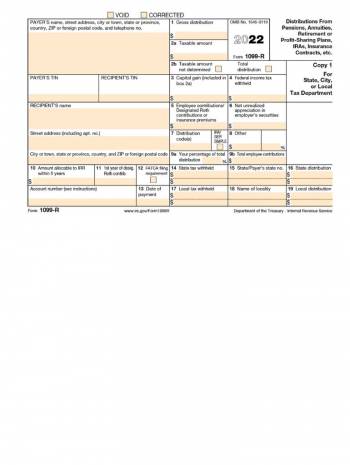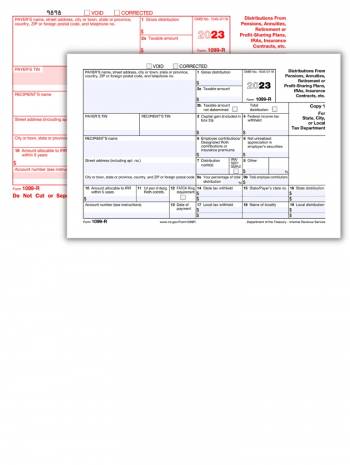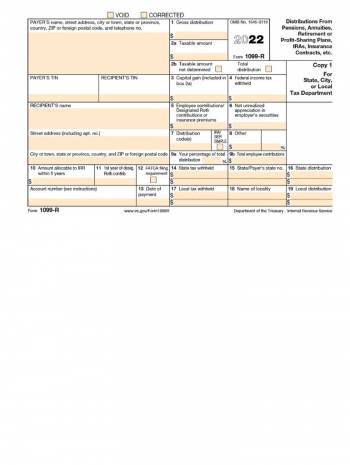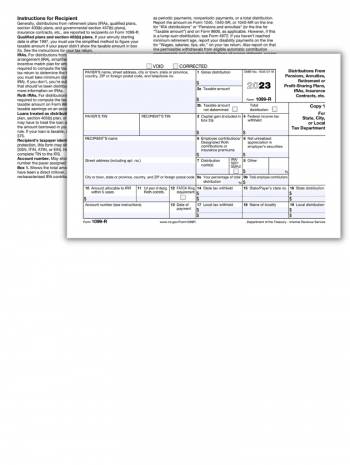1099-R Form Instructions: Overview, Purpose, and Common Mistakes
Taxpayers often find preparing and filing tax forms to be a complicated process, and one of the most daunting tasks is dealing with the 1099-R form. This document reports distributions from retirement plans such as pensions, annuities, and IRAs and is used to inform the IRS and the recipient of the retirement plan distribution, which is subject to taxation. In this article, we will provide an overview of the document, its purpose, usage, and common mistakes to avoid.
Purpose and Usage of the 1099-R Form
The 1099-R form is critical for reporting retirement plan distributions and ensuring compliance with tax laws. It is used to report distributions from retirement plans (pensions, annuities, and IRA accounts) to the IRS and the recipient. Anyone who has received a distribution of $10 or more from a retirement plan throughout the year must receive a 1099-R form from the plan administrator.
Essential Details to Pay Attention to in the 1099-R Template
When working with the 1099-R template, it is essential to pay attention to several critical details. These include:
- Box 1 reports the total amount of the distribution, which is subject to taxation unless it qualifies for an exception.
- Box 2a reports the taxable amount of the distribution. If the entire distribution is taxable, this field will be the same as Box 1. However, if only a portion is taxable, this box will be less than Box 1.
- Line 4 reports the amount of federal income tax withheld from the distribution. If the recipient elected to have taxes withheld from the distribution, this box will show the amount.
- The next line reports the distribution code, which indicates the type of distribution. The codes range from 1 to 7, each with a specific meaning.
- Box 9b reports whether the distribution is from a designated Roth account. In that case, the taxable amount will be reported in Box 2a.
Common Mistakes When Completing Form 1099-R
Some of the most common mistakes people make when completing form 1099-R include entering incorrect information in the boxes, forgetting to include the distribution code in field 7, and failing to include the federal income tax withheld in line 4. These mistakes can lead to errors and result in penalties or additional taxes.
To avoid these mistakes, it is essential to carefully review the information entered in the template and double-check it for accuracy. Additionally, seeking the assistance of a tax professional is advisable if you are unsure about how to complete the sample.
In conclusion, the 1099-R form is a vital document. By paying attention to the essential details and avoiding common mistakes, taxpayers can ensure that their 1099-R forms are accurate and complete. Properly completing and filing this form can save time and money, making it an essential part of the tax filing process.
Related Forms
-
![image]() 1099-R This annual tax document reports distributions from retirement accounts such as pensions, annuities, and other similar plans. The retirement account administrator issues the form to the recipient of the distribution and the Internal Revenue Service (IRS). The purpose of federal tax form 1099-R is to provide the IRS with data about the distribution, including the amount, the type of account, and the recipient's information. The website form1099r.net provides valuable resources for individuals wh... Fill Now
1099-R This annual tax document reports distributions from retirement accounts such as pensions, annuities, and other similar plans. The retirement account administrator issues the form to the recipient of the distribution and the Internal Revenue Service (IRS). The purpose of federal tax form 1099-R is to provide the IRS with data about the distribution, including the amount, the type of account, and the recipient's information. The website form1099r.net provides valuable resources for individuals wh... Fill Now -
![image]() Printable IRS Form 1099-R for 2023 Filing your taxes can be a stressful task, but with this step-by-step guide, filling out the 1099-R form can be a breeze. This form is crucial for reporting distributions from retirement plans, annuities, and insurance contracts. Here's how to obtain and send the printable 1099-R template. How to Obtain the Printable Blank PDF To get started, you'll need to obtain the printable blank PDF of the 1099-R form. You can download it from the IRS website or purchase it from an office supply store. Once you have the template, ensure that you have the appropriate software to fill it out. Rules to Fill in the 1099-R Form Appropriately Filling out the 1099-R form accurately is crucial to avoid any delays or issues. Here are some important rules to follow: Use black ink and a legible font to fill out the form. Do not use dollar signs, commas, or decimal points, as the document has its own formatting. Fill out the payer's name, address, and identification number (if applicable). Fill out the recipient's name, address, and Social Security or taxpayer-identification number. Enter the distribution code in Box 7, which indicates the reason for the distribution. Report the gross distribution amount in Box 1, which is the total amount before any taxes or fees were deducted. If federal income tax was withheld from the distribution, report that amount in Box 4. If the distribution was made from a traditional IRA, report any amounts rolled over to another IRA or qualified plan in Box 2. If the distribution was made from a Roth IRA, report any contributions made during the year in Box 5. If the distribution was withheld from a pension or annuity, report the taxable amount in Box 2a and the total amount of the distribution in Box 2b. If the distribution has been made due to death, report the deceased person's name and their Social Security number in Box 6. Filing the Printable 1099-R Copy Once you've filled out the form, you must send it to both the recipient and the IRS. The deadline for sending the 1099-R to the recipient is January 31st of the year following the distribution. The deadline for filing the 1099-R form with the IRS depends on whether you file electronically or by mail. If you file electronically, the deadline is March 31st. If you file by mail, the deadline is February 28th. To file electronically, you can use the IRS's FIRE (Filing Information Returns Electronically) system. You'll need to create an account, complete the template online, and submit it electronically. To file by mail, you'll need to print out the 1099-R form and mail it to the appropriate address. Be sure to include a copy of the 1099-R with the recipient's federal tax return. Fill Now
Printable IRS Form 1099-R for 2023 Filing your taxes can be a stressful task, but with this step-by-step guide, filling out the 1099-R form can be a breeze. This form is crucial for reporting distributions from retirement plans, annuities, and insurance contracts. Here's how to obtain and send the printable 1099-R template. How to Obtain the Printable Blank PDF To get started, you'll need to obtain the printable blank PDF of the 1099-R form. You can download it from the IRS website or purchase it from an office supply store. Once you have the template, ensure that you have the appropriate software to fill it out. Rules to Fill in the 1099-R Form Appropriately Filling out the 1099-R form accurately is crucial to avoid any delays or issues. Here are some important rules to follow: Use black ink and a legible font to fill out the form. Do not use dollar signs, commas, or decimal points, as the document has its own formatting. Fill out the payer's name, address, and identification number (if applicable). Fill out the recipient's name, address, and Social Security or taxpayer-identification number. Enter the distribution code in Box 7, which indicates the reason for the distribution. Report the gross distribution amount in Box 1, which is the total amount before any taxes or fees were deducted. If federal income tax was withheld from the distribution, report that amount in Box 4. If the distribution was made from a traditional IRA, report any amounts rolled over to another IRA or qualified plan in Box 2. If the distribution was made from a Roth IRA, report any contributions made during the year in Box 5. If the distribution was withheld from a pension or annuity, report the taxable amount in Box 2a and the total amount of the distribution in Box 2b. If the distribution has been made due to death, report the deceased person's name and their Social Security number in Box 6. Filing the Printable 1099-R Copy Once you've filled out the form, you must send it to both the recipient and the IRS. The deadline for sending the 1099-R to the recipient is January 31st of the year following the distribution. The deadline for filing the 1099-R form with the IRS depends on whether you file electronically or by mail. If you file electronically, the deadline is March 31st. If you file by mail, the deadline is February 28th. To file electronically, you can use the IRS's FIRE (Filing Information Returns Electronically) system. You'll need to create an account, complete the template online, and submit it electronically. To file by mail, you'll need to print out the 1099-R form and mail it to the appropriate address. Be sure to include a copy of the 1099-R with the recipient's federal tax return. Fill Now -
![image]() Fillable 1099-R Form for 2023 Filing a 1099-R tax form may seem overwhelming, but utilizing the fillable online version can be a time-saving and straightforward process. Here is a comprehensive guide to filing the 1099-R with ease. Accessing the Fillable 1099-R PDF The fillable 1099-R form is available on the IRS website. To find it, navigate to the forms and publications page, search for "1099-R," and click on "Instructions" and "Fillable 1099-R." This will take you to the appropriate page where you can obtain the form. Steps to Fill in the Online Template Appropriately To ensure accuracy, there are some guidelines to keep in mind when completing the fillable version of the 1099-R: Print legibly with black ink. Avoid using dollar signs or commas in numeric fields. Enter all dollar amounts as positive numbers. Check the "Amended" box if you're correcting a previously filed form. Fill in your name, address, and identification number in the appropriate fields. Filing the Fillable 1099-R Form Correctly Once the template is complete, it must be filed with the IRS and sent to the distribution recipient. The IRS provides several options for filing, such as submitting online, mailing a paper copy, or using an approved e-filing service. Before submitting the form, double-check all information to avoid any errors or penalties. Possible Issues to Consider While using the fillable version of the 1099-R can simplify the filing process, there are some potential issues to consider: When filing multiple copies of the document, be sure to use the correct copy for each recipient (Copy A for the IRS, Copy B for the recipient, etc.). Late filing may result in penalties or fees. To avoid additional charges, ensure to file by the appropriate deadline. Seek guidance from a tax professional or review the instructions if unsure how to fill out a specific field. Filing taxes accurately can save retirees and annuitants time, money, and stress in the long run. Utilizing the fillable version of the 1099-R form can make the process more manageable. Fill Now
Fillable 1099-R Form for 2023 Filing a 1099-R tax form may seem overwhelming, but utilizing the fillable online version can be a time-saving and straightforward process. Here is a comprehensive guide to filing the 1099-R with ease. Accessing the Fillable 1099-R PDF The fillable 1099-R form is available on the IRS website. To find it, navigate to the forms and publications page, search for "1099-R," and click on "Instructions" and "Fillable 1099-R." This will take you to the appropriate page where you can obtain the form. Steps to Fill in the Online Template Appropriately To ensure accuracy, there are some guidelines to keep in mind when completing the fillable version of the 1099-R: Print legibly with black ink. Avoid using dollar signs or commas in numeric fields. Enter all dollar amounts as positive numbers. Check the "Amended" box if you're correcting a previously filed form. Fill in your name, address, and identification number in the appropriate fields. Filing the Fillable 1099-R Form Correctly Once the template is complete, it must be filed with the IRS and sent to the distribution recipient. The IRS provides several options for filing, such as submitting online, mailing a paper copy, or using an approved e-filing service. Before submitting the form, double-check all information to avoid any errors or penalties. Possible Issues to Consider While using the fillable version of the 1099-R can simplify the filing process, there are some potential issues to consider: When filing multiple copies of the document, be sure to use the correct copy for each recipient (Copy A for the IRS, Copy B for the recipient, etc.). Late filing may result in penalties or fees. To avoid additional charges, ensure to file by the appropriate deadline. Seek guidance from a tax professional or review the instructions if unsure how to fill out a specific field. Filing taxes accurately can save retirees and annuitants time, money, and stress in the long run. Utilizing the fillable version of the 1099-R form can make the process more manageable. Fill Now -
![image]() Federal Tax Form 1099-R Tax season can be a stressful time for many Americans, especially those who are unfamiliar with the various tax forms required by the IRS. One such form is the 1099-R, which reports distributions from retirement plans and annuities. This article will delve into the form's history, its purpose for the 2023 tax year, any exemptions for its use, and any changes in the template compared to previous years. The History of the 1099-R Form The 1099-R form has been in use since the 1980s when it was introduced by the Internal Revenue Service (IRS) as part of a larger effort to increase compliance with tax laws. The document was designed to help the IRS keep track of distributions made from retirement plans and annuities, which were previously difficult to track due to the number of different plans and payment options available. Why Must People Use the Form in 2023 Year? In 2023, people must use the 1099-R to report distributions received from retirement plans and annuities. Failure to report these distributions accurately can result in penalties and fines from the IRS. Individuals can use the 1099-R template to ensure that their distributions are reported correctly and avoid any potential issues with the IRS. Exemptions for Using the Form While most individuals who receive distributions from retirement plans and annuities must use the 1099-R form, this rule has a few exemptions. Some exemptions include: Distributions made to an individual who is under the age of 59 ½ and has a qualified exception (e.g., disability, medical expenses) Distributions made to an individual who has purchased a qualified longevity annuity contract (QLAC) Changes in the 1099-R Form for 2023 As with many tax forms, the IRS updates the 1099-R template periodically to reflect tax laws and regulations changes. For the 2023 tax year, there are a few changes to note: New Distribution CodesThe IRS added two new codes to the 1099-R form. The first code, "IRSD," is used to report qualified disaster distributions, which are distributions made in response to a presidentially declared disaster. The second code, "IRSA," reports qualified adoption distributions, which are distributions made to cover adoption expenses. Changes to the IRA Distribution Code ChartThe IRA Distribution Code Chart, which indicates the type of distribution being made from an IRA, has been updated for the 2023 tax year. The updated chart includes new codes for qualified disaster and adoption distributions. Changes to the 2023 General Instructions for Certain Information ReturnsThe IRS has updated the general instructions for certain information returns, including the 1099-R form. These instructions include information on the new distribution codes and the IRA Distribution Code Chart changes. Fill Now
Federal Tax Form 1099-R Tax season can be a stressful time for many Americans, especially those who are unfamiliar with the various tax forms required by the IRS. One such form is the 1099-R, which reports distributions from retirement plans and annuities. This article will delve into the form's history, its purpose for the 2023 tax year, any exemptions for its use, and any changes in the template compared to previous years. The History of the 1099-R Form The 1099-R form has been in use since the 1980s when it was introduced by the Internal Revenue Service (IRS) as part of a larger effort to increase compliance with tax laws. The document was designed to help the IRS keep track of distributions made from retirement plans and annuities, which were previously difficult to track due to the number of different plans and payment options available. Why Must People Use the Form in 2023 Year? In 2023, people must use the 1099-R to report distributions received from retirement plans and annuities. Failure to report these distributions accurately can result in penalties and fines from the IRS. Individuals can use the 1099-R template to ensure that their distributions are reported correctly and avoid any potential issues with the IRS. Exemptions for Using the Form While most individuals who receive distributions from retirement plans and annuities must use the 1099-R form, this rule has a few exemptions. Some exemptions include: Distributions made to an individual who is under the age of 59 ½ and has a qualified exception (e.g., disability, medical expenses) Distributions made to an individual who has purchased a qualified longevity annuity contract (QLAC) Changes in the 1099-R Form for 2023 As with many tax forms, the IRS updates the 1099-R template periodically to reflect tax laws and regulations changes. For the 2023 tax year, there are a few changes to note: New Distribution CodesThe IRS added two new codes to the 1099-R form. The first code, "IRSD," is used to report qualified disaster distributions, which are distributions made in response to a presidentially declared disaster. The second code, "IRSA," reports qualified adoption distributions, which are distributions made to cover adoption expenses. Changes to the IRA Distribution Code ChartThe IRA Distribution Code Chart, which indicates the type of distribution being made from an IRA, has been updated for the 2023 tax year. The updated chart includes new codes for qualified disaster and adoption distributions. Changes to the 2023 General Instructions for Certain Information ReturnsThe IRS has updated the general instructions for certain information returns, including the 1099-R form. These instructions include information on the new distribution codes and the IRA Distribution Code Chart changes. Fill Now -
![image]() Form 1099-R Examples for 2023 Tax season can be a daunting time for many Americans, especially those unfamiliar with the various tax forms required by the IRS. One form that can confuse is the 1099-R form, used to report retirement plans and annuity distributions. In this essay, we will explore the 1099-R form in detail, providing several examples of unusual cases where people must file this document, along with completed templates for each case. Examples of Unusual Cases Early DistributionsIn most cases, individuals who receive distributions from retirement plans and annuities must use the 1099-R template. However, there are some exceptions to this rule. For example, suppose an individual is under 59 ½ and receives an early distribution from their retirement plan or annuity. In that case, they may still be required to file a 1099-R form if they have a qualified exception. For instance, if an individual is disabled or has medical expenses that exceed 7.5% of their adjusted gross income, they may qualify for an exception. Annuity PaymentsAnother example of when an individual must file a 1099-R form is when they receive annuity payments from a retirement plan. In this case, the individual must report the payments they receive on their tax return. The amount of taxable payments depends on several factors, including the individual's age, the amount of their original investment, and the type of annuity they have. If the individual has a qualified annuity, they may be able to exclude a portion of the payments from their taxable income. Distributions from Inherited Retirement PlansWhen an individual inherits a retirement plan or annuity from a deceased individual, they may be required to file a 1099-R sample. In this situation, the individual must report their distributions on their tax return. The number of the taxable distributions depends on several factors, including the age of the deceased individual at the time of their death and the type of retirement plan or annuity they had. If the individual is a beneficiary of a Roth IRA, the distributions may be tax-free. In conclusion, the 1099-R form is essential for individuals who receive distributions from retirement plans and annuities. Besides, there are exceptions to this rule. It is essential to be aware of these exceptions and consult a tax professional if there are any questions or concerns about using the 1099-R form. By accurately reporting distributions using the 1099-R form, individuals can avoid penalties and fines from the IRS. Fill Now
Form 1099-R Examples for 2023 Tax season can be a daunting time for many Americans, especially those unfamiliar with the various tax forms required by the IRS. One form that can confuse is the 1099-R form, used to report retirement plans and annuity distributions. In this essay, we will explore the 1099-R form in detail, providing several examples of unusual cases where people must file this document, along with completed templates for each case. Examples of Unusual Cases Early DistributionsIn most cases, individuals who receive distributions from retirement plans and annuities must use the 1099-R template. However, there are some exceptions to this rule. For example, suppose an individual is under 59 ½ and receives an early distribution from their retirement plan or annuity. In that case, they may still be required to file a 1099-R form if they have a qualified exception. For instance, if an individual is disabled or has medical expenses that exceed 7.5% of their adjusted gross income, they may qualify for an exception. Annuity PaymentsAnother example of when an individual must file a 1099-R form is when they receive annuity payments from a retirement plan. In this case, the individual must report the payments they receive on their tax return. The amount of taxable payments depends on several factors, including the individual's age, the amount of their original investment, and the type of annuity they have. If the individual has a qualified annuity, they may be able to exclude a portion of the payments from their taxable income. Distributions from Inherited Retirement PlansWhen an individual inherits a retirement plan or annuity from a deceased individual, they may be required to file a 1099-R sample. In this situation, the individual must report their distributions on their tax return. The number of the taxable distributions depends on several factors, including the age of the deceased individual at the time of their death and the type of retirement plan or annuity they had. If the individual is a beneficiary of a Roth IRA, the distributions may be tax-free. In conclusion, the 1099-R form is essential for individuals who receive distributions from retirement plans and annuities. Besides, there are exceptions to this rule. It is essential to be aware of these exceptions and consult a tax professional if there are any questions or concerns about using the 1099-R form. By accurately reporting distributions using the 1099-R form, individuals can avoid penalties and fines from the IRS. Fill Now




